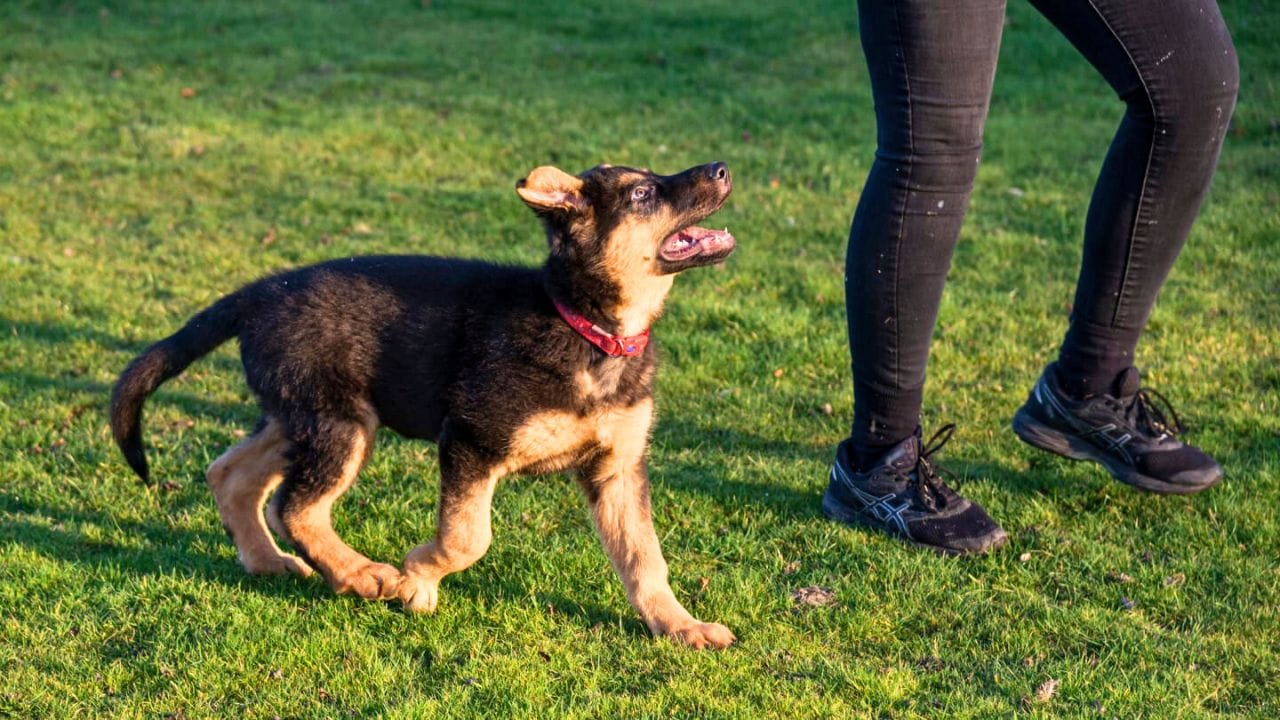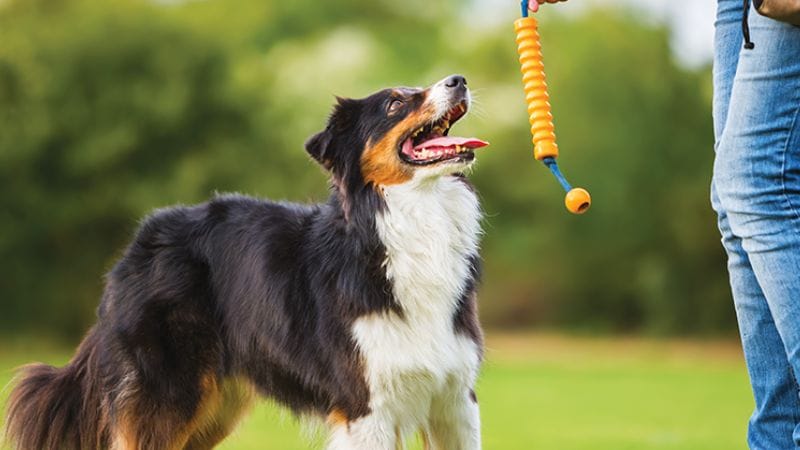Dogs are known for their loyal and affectionate nature towards their owners. They can be seen following their owners everywhere, whether it be to the bathroom, the kitchen, or even on a walk. This behavior is often seen as a sign of love and attachment, but have you ever wondered why dogs follow their owners everywhere?

One reason for this behavior is that dogs are pack animals by nature. In the wild, dogs would live in packs and follow their leader wherever they went. When dogs are domesticated, they see their owners as their pack leader and instinctively follow them. This behavior is also reinforced by positive reinforcement from owners, who often give their dogs attention and treats when they follow them.
Another reason for this behavior is that dogs have a strong bond with their owners. Dogs are social animals and crave attention and companionship. When they follow their owners, they are seeking that connection and are happy to be in their presence. This behavior can also be a sign of separation anxiety, as dogs may feel anxious when their owners are not around and follow them to feel more secure.
Overall, dogs follow their owners for a variety of reasons, including their pack mentality and strong bond with their owners. Understanding why dogs exhibit this behavior can help owners better understand and communicate with their furry companions.

Understanding Dog Behavior
Dogs are known for their loyalty and affection towards their human companions. They are social animals and have a strong pack instinct. Understanding why dogs follow their owners everywhere requires an understanding of their behavior.
Social and Pack Instincts
Dogs are pack animals and have a natural instinct to be around their pack. In the wild, dogs would travel in packs for hunting and survival. Domesticated dogs still have this pack instinct and consider their human family as their pack. They feel more secure and comfortable when they are with their pack and hence tend to follow them everywhere.
Breed-Specific Tendencies
Different breeds of dogs have different tendencies when it comes to following their owners. Some breeds like Border Collies, Shepherds, and Labrador Retrievers are known as "velcro dogs" as they tend to stick to their owners like glue. These breeds were originally bred as working dogs and have a strong sense of loyalty towards their human companions.
On the other hand, toy breeds like the Great Pyrenees and Shelties may not follow their owners as closely as working dogs. These breeds were bred for companionship, and while they enjoy being around their owners, they may not feel the need to follow them everywhere.
Imprinting and Bonding
Dogs can also develop a strong attachment to their owners through imprinting and bonding. Imprinting occurs when a puppy is exposed to a person or object during a critical period of development and develops a strong attachment to it. Bonding occurs through positive experiences and interactions with an owner over time.
Dogs may also have a favorite person in the family, someone they feel most comfortable with and prefer to be around. This preference may be due to the person's personality, scent, or the amount of time spent with the dog.
In conclusion, dogs follow their owners everywhere due to their natural pack instinct, breed-specific tendencies, and the bond and attachment they develop with their human companions. Understanding these behaviors can help owners provide the best care and companionship for their canine companions.
Emotional Factors Influencing Behavior
Dogs are known for their loyalty and affection towards their owners. They often follow their owners everywhere they go, and this behavior can be attributed to various emotional factors. In this section, we will explore some of the emotional factors that influence a dog's behavior.
Anxiety and Stress Responses
One of the most common reasons why dogs follow their owners everywhere is anxiety or stress. Dogs can become anxious and stressed for various reasons, such as separation anxiety, thunderstorms, fireworks, and other loud noises. An anxious dog may follow their owner around the house, seeking comfort and safety. They may also become clingy and appear to be a "velcro dog," sticking to their owner's side at all times.
Seeking Comfort and Safety
Dogs see us as their protectors and often seek comfort and safety from us. They feel safe when they are near their owners and may follow them around to create a safe space. This behavior is especially common in dogs that lack confidence and are anxious or fearful. By staying close to their owners, they feel protected and secure.
In conclusion, dogs follow their owners everywhere due to various emotional factors such as anxiety, stress, lack of confidence, and the need for comfort and safety. As a dog owner, it is essential to understand your dog's behavior and provide them with the love and care they need to feel safe and secure.
Behavioral Training and Reinforcement
Training Techniques
One way to encourage a dog to follow their owner is through training techniques. This can include teaching the dog to stay close to their owner, follow specific commands, and adhere to a daily routine. A professional dog trainer can work with the owner and dog to create a training plan that is tailored to their specific needs.

Reward-Based Interactions
Positive reinforcement is a key aspect of encouraging good behavior in dogs. This can include using treats or rewards to reinforce good behavior, such as following their owner. When a dog associates following their owner with receiving a reward, they are more likely to continue the behavior. It is important to note that rewards should only be given for good behavior, and not used as a bribe.
Overall, through a combination of training techniques and reward-based interactions, owners can encourage their dogs to follow them and adhere to a routine. By reinforcing good behavior and providing a clear set of rules, dogs can learn to stay close to their owners and follow their commands.
Physical and Mental Needs
Dogs are social animals that require physical and mental stimulation to stay healthy and happy. When dogs follow their owners everywhere, it is often a sign that they are seeking attention, stimulation, or exercise.
Exercise and Stimulation
Dogs need regular exercise to maintain their physical health and prevent boredom. Daily walks, runs, or playtime can help burn off excess energy and keep dogs mentally stimulated. Without enough exercise, dogs may become restless, destructive, or even aggressive.
In addition to physical exercise, dogs also need mental stimulation to keep their minds active and engaged. Interactive toys, puzzles, and games can provide mental exercise and keep dogs entertained while their owners are away.
Curiosity and Exploration
Dogs are naturally curious animals that enjoy exploring their environment. When dogs follow their owners everywhere, it may be a sign that they are interested in discovering new things or experiencing new environments.
Providing dogs with opportunities to explore their surroundings can help satisfy their curiosity and prevent boredom. Taking dogs on walks to new places, introducing them to new people and animals, or providing them with new toys or treats can help keep their minds engaged and prevent destructive behavior.
Overall, dogs follow their owners everywhere because they have unmet needs for interaction, social interaction, exercise, energy, stimulation, mental exercise, daily exercise, mental stimulation, curiosity, and new things. By understanding these needs and providing appropriate outlets for them, owners can help keep their dogs happy, healthy, and well-behaved.
Health and Aging Factors
Senior Dogs and Health Issues
As dogs age, they may develop various health issues that can affect their behavior. Senior dogs may experience pain, discomfort, and other age-related changes that can make them more dependent on their owners. This can lead to increased following behavior as the dog seeks comfort and reassurance from their owner.

Furthermore, senior dogs may experience behavior changes such as increased anxiety, confusion, and disorientation. These changes can also contribute to increased following behavior as the dog seeks the comfort and security of their owner.
Veterinarian Insights
Veterinarians suggest that dogs may follow their owners as a sign of affection and loyalty. However, they also recommend that owners pay attention to their dog's behavior and monitor for any signs of illness or discomfort.
In some cases, dogs may follow their owners due to separation anxiety or other behavioral issues. It is essential to consult with a veterinarian or professional dog trainer to address any underlying behavioral problems that may be contributing to excessive following behavior.
Overall, it is important to understand that dogs may follow their owners for various reasons, including health and aging factors. By providing proper care and attention, owners can ensure that their dogs remain confident, happy, and independent throughout their lives.
Human-Dog Relationship Dynamics
Dogs have been known to follow their owners everywhere they go, from the living room to the bathroom. This behavior is often seen as a sign of loyalty and affection, but what are the underlying dynamics of the human-dog relationship that lead to this behavior?
The Role of Human Behavior
One factor that contributes to a dog's tendency to follow its owner is the attention and social interactions that the owner provides. Dogs are naturally social animals and crave attention and bonding with their pet parents. When owners consistently provide attention and affection to their dogs, the dogs are more likely to follow them around.
In addition, the rules and boundaries that owners establish can also play a role in a dog's behavior. When owners consistently enforce rules and provide structure, dogs are more likely to feel secure and confident in their place within the home. This can lead to increased loyalty and a desire to be near their owners.

Establishing Boundaries and Independence
While the desire to be near their owners is natural for dogs, it is also important for owners to establish boundaries and encourage independence. Dogs that are overly dependent on their owners can become anxious and exhibit destructive behaviors when left alone.
To promote independence, owners can provide their dogs with a designated place to rest and relax, such as a crate or bed. This can help dogs feel secure and comfortable while still allowing them to have their own space.
Overall, the human-dog relationship is complex and multifaceted. By understanding the role of attention, bonding, social interactions, rules, and independence, owners can promote a healthy and fulfilling relationship with their furry companions.
Common Questions Addressed
Why Dogs Follow to the Bathroom
It is a common occurrence for dogs to follow their owners everywhere, including the bathroom. Many people wonder why their furry shadow feels the need to accompany them into such a private space. The answer is simple: habit. Dogs are creatures of habit and routine, and when they see their owner heading towards the bathroom, they assume it is part of their daily routine and follow them.
Additionally, dogs are pack animals and view their owners as part of their pack. Following their owner to the bathroom allows them to stay close and keep an eye on their pack leader. It is also possible that dogs feel vulnerable when their owner is in the bathroom and want to ensure their safety.
Dealing With Clingy or Velcro Dogs
Some dogs are more clingy than others and are often referred to as "velcro dogs." While this behavior can be endearing, it can also become overwhelming for some owners. To deal with clingy dogs, it is important to establish boundaries and teach them independence.
One way to do this is to gradually increase the amount of time the dog spends alone. Start by leaving the room for a few minutes and gradually increase the time as the dog becomes more comfortable. It is also important to reward the dog for independent behavior and not reinforce clingy behavior.
When it comes to velcro dogs, it is important to choose a breed that matches your lifestyle. Some breeds, such as the Australian Shepherd and the Golden Retriever, are known for their clingy behavior and may not be the best fit for someone who values their personal space.
Overall, understanding why dogs follow their owners everywhere and how to deal with clingy behavior can help create a happier and healthier relationship between dogs and their owners.
Conclusion:
In conclusion, dogs follow their owners for a variety of reasons, including their natural pack instincts, emotional bonding, and individual personality traits. Understanding these underlying factors can help owners appreciate the depth of their relationship with their canine companions and the loyalty and affection that drive this behavior. While it's heartwarming to have a furry friend that wants to be by your side at all times, it's also important to encourage independence and set boundaries to ensure your dog feels secure and confident even in your absence.
For those dealing with clingy or "velcro" dogs, establishing a routine that includes time for independence, along with positive reinforcement for confident behavior, can help mitigate anxiety and overly dependent tendencies. Remember that each dog has its unique personality, and what works for one may not work for another. Consulting with a professional trainer or veterinarian can provide tailored advice for managing and understanding your dog's specific needs and behaviors.
Ultimately, the close bond between dogs and their owners is something to be cherished. By fostering a healthy, balanced relationship with clear communication and mutual respect, owners can ensure a happy and fulfilling life for their loyal companions. Whether following you to the bathroom or waiting patiently for your return, dogs show their love in various ways, and understanding these behaviors strengthens the special bond we share with our four-legged friends.